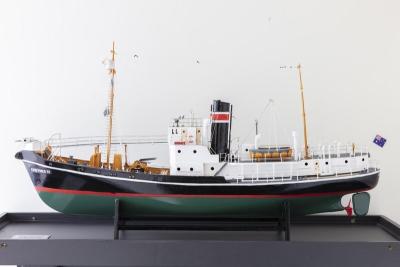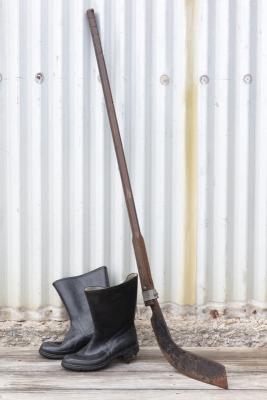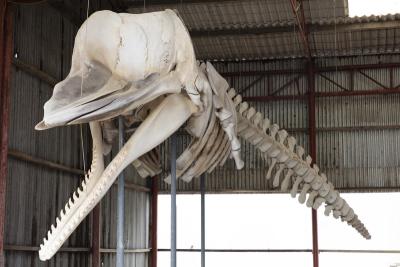PAINTINGS - (a)SPECTACLED PORPOISE (b)BURMEISTER'S PORPOISE
c. 19752 paintings in single framed work (a) SPECTACLED PORPOISE - Stocky bodied , two toned black and white, beakless porpoise with white rings around its eyes and rounded dorsal fin (40) (b) BURMEISTER'S PORPOISE - Grey, stocky bodied with a blunt, beakless head, and triangular dorsal fin set toward the back of the body; gouache on blue card, framed and mounted with inscription
Collection of 106 of paintings by Richard Ellis that were selected by the Smithsonian Institution to form a traveling exhibit of the marine mammals of the world. The collection was purchased by Perth businessman Kevin Parry in 1985 and donated to Whale World, now known as Albany's Historic Whaling Station.
These were originally framed with RE.1999.320 a-d & have now been split up & reframed.
Details
Details
SPECTACLED PORPOISE (Phocoena dioptrica)
Black on the dorsal surface with a pronounced white eye-ring and black lips, this little porpoise is found in the region of Cape Horn and Tierra del Fuego. The spectacled porpoise was previously known only from southern South American waters, but a recent skeleton from the Auckland Islands (south of New Zealand) suggests a circumpolar distribution. The male has a greatly exaggerated dorsal - a feature not known to occur in any other small cetacean. 40.
BURMEISTER'S PORPOISE (Phocoena spinipinnis)
Although regularly referred to as the "black porpoise," this animal is, in face, light brown in color. Spinnipinnis means "spiny fin", and the name is derived from the denticles or spines on the leading edge of the unusually shaped dorsal fin. It is convex on the leading edge and concave on the trailing edge, another distinguishing - and unique- characteristic. Like all the other phocoenids, Burmeister's porpoise has little spade-shaped teeth, and is also small and unobtrusive, rarely reaching a length of 6 feet. It is found in the coastal waters of eastern and western South America, from Peru around the Horn to Uruguay.
The paintings represent a body of work by well-known American marine conservationist, author, artist and natural historian Richard Ellis (1938-2024).
Copyright and Reference
Copyright and Reference
Albany's Historic Whaling Station
Albany's Historic Whaling Station
Other items by Richard Ellis
- PAINTINGS - (a) GANGES RIVER DOLPHIN (b)INDUS RIVER DOLPHIN
- PAINTING - CHINESE RIVER DOLPHIN
- PAINTING - BAIKAL SEAL
- PAINTINGS - (a) RIGHT WHALE & (b) BOWHEAD WHALE
- PAINTING - MEDITERRANEAN MONK SEAL
- PAINTING - FALSE KILLER WHALE
- PAINTING - HOURGLASS DOLPHIN
- PAINTING - FRANCISCANA
- PAINTINGS - (a)FRASER'S DOLPHIN & (b)WHITE BEAKED DOLPHIN
- PAINTINGS - (a) MINKE WHALE & (b) BRYDE'S WHALE
- PAINTING - SOUTHERN BOTTLENOSE WHALE
- PAINTINGS - (a) CARIBBEAN MONK SEAL (b) HAWAIIAN MONK SEAL
More items like this
Other items from Albany's Historic Whaling Station
- PAINTINGS - (a)CLYMENE DOLPOHIN (b)ATLANTIC SPOTTED DOLPHIN
- PAINTINGS - (a) DUSKY DOLPHIN & (b) PEALE'S DOLPHIN
- PAINTINGS - (a) SOUTHERN ELEPHANT SEAL (b) NORTHERN ELEPHANT SEAL
- PAINTINGS - (a) WEST AFRICAN HUMPBACK DOLPHIN & (b) TUCUXI
- PAINTING - SEI WHALE
- PAINTINGS - (a) BAIRD'S BEAKED WHALE (b) GOOSEBEAK WHALE
- MODEL OF A WHALE CHASER
- FLENSING KNIFE AND BOOTS
- SPERM WHALE SKELETON



